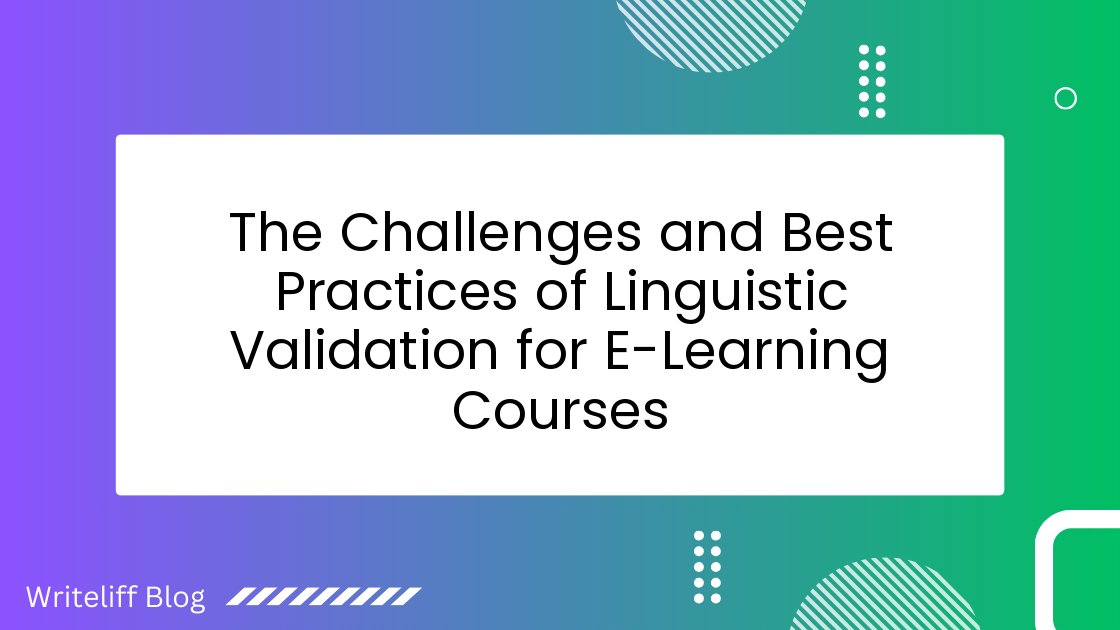The Challenges and Best Practices of Linguistic Validation for E-Learning Courses

As e-learning continues to grow in popularity, it’s essential to ensure that courses are accessible and understandable to a global audience. One crucial aspect of achieving this is through linguistic validation. In this blog post, I will discuss the challenges and best practices of linguistic validation for e-learning courses and how a professional translation service can help you overcome these challenges. Let’s dive in!
Understanding Linguistic Validation
Linguistic validation is a process that ensures translated content is not only accurate but also culturally appropriate and easily understood by the target audience. This process is particularly important in the context of e-learning courses, where accurate communication is essential for effective learning. The linguistic validation process typically involves several steps, including:
- Forward translation: Translating the source content into the target language by a native speaker of the target language.
- Back translation: Translating the forward-translated content back into the source language by a different translator to check for consistency and accuracy.
- Harmonization: Comparing the back-translated content with the original source content to identify and resolve any discrepancies.
- Cognitive debriefing: Testing the translated content with a sample of the target audience to ensure it is easily understood and culturally appropriate.
Challenges of Linguistic Validation for E-Learning Courses
There are several challenges associated with linguistic validation for e-learning courses:
1. Cultural Differences
One of the main challenges of linguistic validation is accounting for cultural differences. Concepts and expressions that are easily understood in one culture may not have an equivalent in another culture. For example, a survey question asking, “how bad do you feel,” would require finding the best way to convey the same sentiment and meaning in another language and culture, ensuring that the translated content is culturally appropriate.
2. Technical Terminology
E-learning courses often involve technical terminology specific to a particular field or industry. Ensuring that these terms are accurately translated and easily understood by the target audience can be challenging, as some terms may not have direct equivalents in the target language.
3. Multimedia Content
E-learning courses often include multimedia content, such as videos, images, and interactive elements. Linguistic validation for these elements can be more complex, as it may involve translating captions, subtitles, and on-screen text, as well as ensuring that the translated content is synchronized with the multimedia elements.
Best Practices for Linguistic Validation of E-Learning Courses
To overcome these challenges, consider the following best practices for linguistic validation of e-learning courses:
1. Work with a Professional Translation Service
Partnering with a professional translation service can help ensure that your e-learning course is accurately translated and culturally appropriate. These services typically employ native speakers of the target language who are also subject matter experts in your field, ensuring that technical terminology is accurately translated.
2. Use a Consistent Style Guide
Developing a consistent style guide for your e-learning course can help ensure that the translated content is consistent and easily understood by the target audience. This guide should include information on terminology, tone, and formatting, as well as any specific cultural considerations for the target audience.
3. Test the Translated Content
Before launching your e-learning course, it’s essential to test the translated content with a sample of the target audience. This cognitive debriefing process can help identify any issues with the translated content and ensure that it is easily understood and culturally appropriate.
4. Continuously Update and Improve
As with any educational content, it’s essential to continuously update and improve your e-learning course based on feedback from the target audience. This may involve making adjustments to the translated content or incorporating new information as it becomes available.
Conclusion
In conclusion, linguistic validation is a critical aspect of ensuring that e-learning courses are accessible and understandable to a global audience. By working with a professional translation service and following best practices for linguistic validation, you can overcome the challenges associated with translating e-learning content and ensure that your course is effective and engaging for learners around the world.
